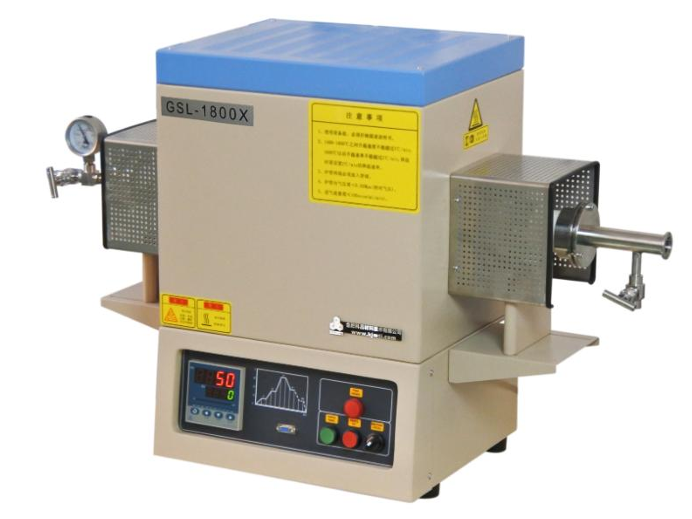
Operating Procedures of Vacuum Tube Furnace
2025-10-29 10:58For B-end buyers in the fields of material research and development and semiconductor manufacturing, mastering the standardized operation of small vacuum tube furnace can ensure experimental safety, data repeatability and equipment life. Relying on its compact design and precise temperature control, this small vacuum tube furnace has become the preferred choice for small-batch high-temperature vacuum experiments in university laboratories, R&D centers and small and medium-sized enterprises. In this article, I will introduce you to the full-process operating procedures of small vacuum tube furnace to help you give full play to the performance of your equipment.
Three inspections need to be completed before starting the small vacuum tube furnace to avoid potential risks. The first item is the inspection of the status of the equipment. It is necessary to confirm that the outer shell of the furnace is not damaged, the furnace tube is not cracked, the power cord and control line are firmly connected, and the vacuum system is not loose or aging. The second item is to check the air-cooling system. You need to confirm that the appearance of the cooling fan of the small vacuum tube furnace is not damaged and the air outlet is not blocked. After the power is turned on, test whether the fan is operating normally, and check whether the fan dust-proof net is clean to avoid overheating and damage to the internal components of the furnace due to poor heat dissipation. The last is the preparation of samples and tooling. Combined with the length characteristics of the heating zone of 150mm of the equipment, it is necessary to choose a suitable small sample boat, place the samples evenly in the boat, and then slowly push the sample boat into the heating zone in the center of the furnace tube, close the furnace door and tighten the flange buckle to make the vacuum sealing surface fit tightly.
In the start-up phase, it is necessary to operate in accordance with the principle of vacuum priority. First turn on the power supply of the vacuum pump and slowly open the vacuum valve. After the vacuum degree reaches the standard value of the equipment, it will continue to run for 10 to 15 minutes to eliminate residual air in the furnace tube. Then start the temperature control system and set the heating curve. The heating rate is recommended to be 2 to 10℃/min. It should be noted that 1800℃ is the short-term peak temperature of small vacuum tube furnace. A single continuous use cannot exceed 30 minutes. It is recommended to use 800 to 1750℃ for conventional work, which can extend the life of the silicon-molybdenum rod heating element.

During the heating process, you need to pay dynamic attention to parameter changes. 30 minutes before the target temperature, record the temperature control display temperature and vacuum gauge readings every 5 minutes, so that the deviation between the actual temperature and the set value is ≤±1℃, and confirm that there is no abnormal fluctuation in the degree of vacuum. At the same time, you need to check the status of the air-cooled system every 10 minutes, and touch the side of the small vacuum tube furnace shell to confirm that the temperature has not risen abnormally and the fan continues to operate stably. When the temperature reaches the target value, it enters the thermal insulation stage. At this time, it is necessary to keep the vacuum pump running continuously, and it is necessary to avoid frequent adjustment of temperature parameters during the thermal insulation stage to prevent excessive temperature fluctuations from affecting the experimental results. In addition, it is forbidden to open the furnace door or adjust the flange buckle during the insulation stage to avoid the sudden entry of air into the furnace tube to cause oxidation reaction, or the furnace tube to break due to sudden pressure changes.
After the experiment is over, it is necessary to cool down according to the process. First turn off the heating function of the temperature control system, keep the cooling system and the vacuum pump running, and wait for the temperature in the furnace to drop below 300℃, then turn off the vacuum pump, and slowly open the vacuum valve to pass into the inert gas to balance the pressure. When the temperature drops further below 100℃, the furnace door can be opened to take out the sample boat. Of course, follow-up maintenance cannot be ignored. After the experiment is over, use a dust-free cloth dipped in alcohol to clean up the remaining sample debris in the furnace tube, and also check whether the vacuum sealing ring is worn out. If it is deformed or aging, it needs to be replaced in time. Finally, turn off the power supply of all equipment, clean the fan dust-proof net, record the temperature curve, vacuum degree changes and equipment operating status of this experiment, and form an operation log to provide a reference for the subsequent maintenance and process optimization of small vacuum tube furnace.
